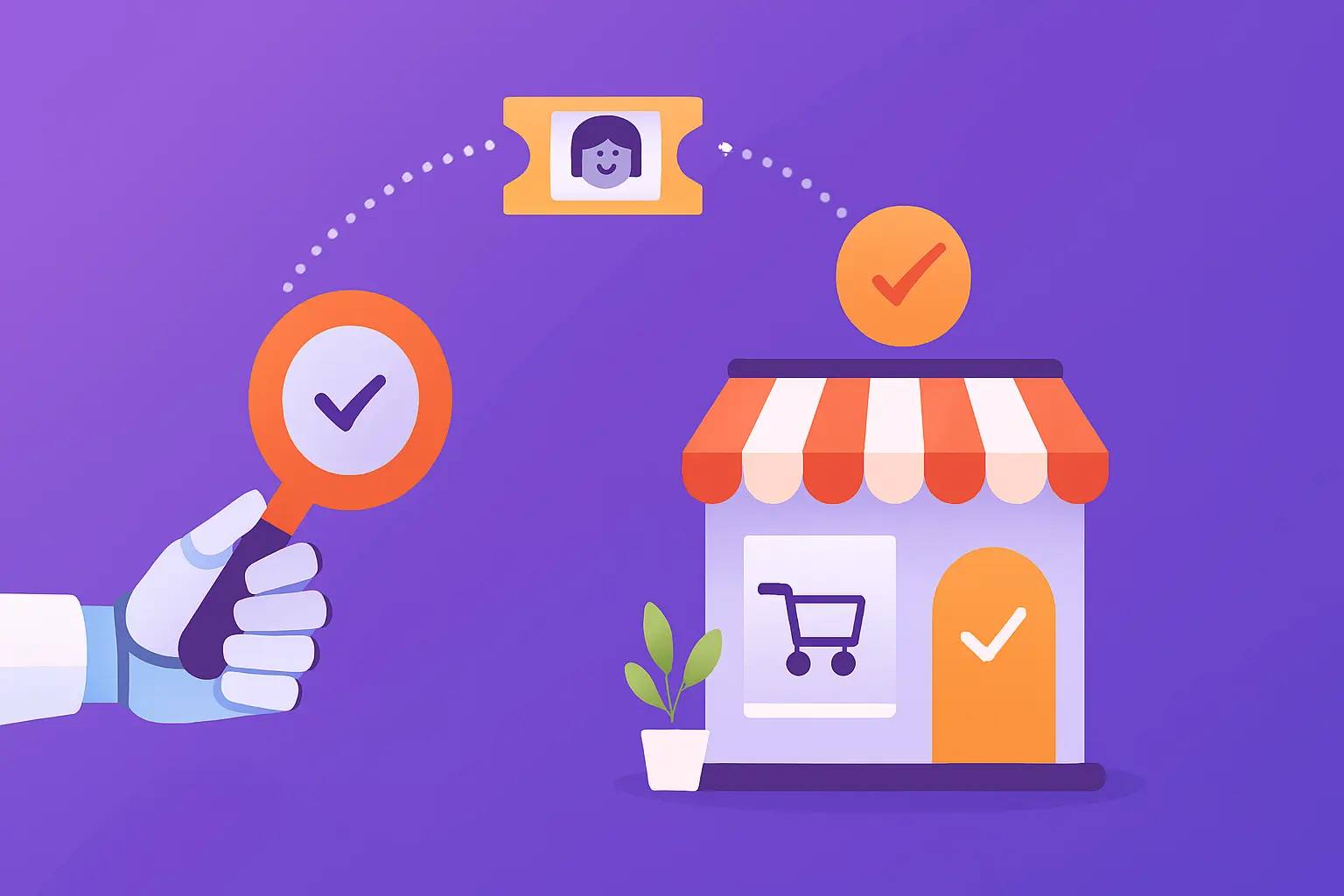A Comprehensive Guide to Customer Acquisition
- April 26, 2022
- 36 mins read
- Listen

Customer acquisition isn’t merely about casting a wide net. It’s an intricate dance of understanding, engagement, and value proposition, whereas, a customer acquisition strategy is a tool that helps brands acquire new customers and increase their brand awareness. It’s important because it has a significant impact on the growth of your business.
If your company has been in business for more than a year. You know that growth is an important part of any healthy brand. If your business is small, growth can be vital to its survival.
One of the best things about implementing a customer acquisition strategy is that it gives you more exposure as a brand. You can start reaching out to potential customers who were previously unaware of you or your products and services.
In this comprehensive guide, you’ll discover all the vital things related to customer acquisition.
What is Customer Acquisition?

Customer acquisition refers to the process of gaining new customers or clients for a business. It involves various marketing and sales strategies aimed at attracting customers or companies who haven’t previously purchased from a specific brand or used its services. The goal is to convert these prospects into paying customers.
This process encompasses a range of activities, from identifying potential customers to engaging them through marketing campaigns, sales efforts, and other initiatives. It often involves understanding customer needs, creating targeted messages or offers, and guiding individuals through the sales funnel. Ultimately, it leads them to make a purchase or commit to a service.
Customer acquisition is a vital aspect of business growth. The purpose of customer acquisition is to expand the customer base can drive revenue, increase market share, and establish a more robust brand presence in the marketplace. Why is Customer Acquisition Important?
Customer acquisition is vital for a business. An effective acquisition strategy can change the entire business scenario. Now let’s find the key reasons why it is crucial for a business.
- It represents a potential source of income through their initial purchase and repeat purchases over time.
- It allows businesses to expand their market reach and tap into new demographics or geographic regions.
- In competitive markets, customer acquisition is essential for gaining market share and outperforming competitors.
- This ensures a steady influx of revenue and offsets customer churn or attrition, which naturally occurs over time.
- It provides valuable insights into customer preferences, behaviors, and market trends. Businesses can innovate their products, services, and marketing strategies to better meet customer demands and stay relevant in a dynamic marketplace.
- This stimulates economic activity by creating demand for goods and services, which, in turn, drives production, investment, and job creation.
- This is an opportunity to build brand awareness and reputation. Delivering a positive experience to new customers can lead to word-of-mouth referrals and positive reviews.
Customer Acquisition Statistics
To measure its significance let’s take a look at some vital customer acquisition statistics. These will provide you a clear demonstration of why effective customer acquisition is crucial for a business.
- According to SEMRush, about 44% of businesses focus on customer acquisition. However, only 18% put forth the much-needed efforts to retain existing customers.
- Email marketing has an average ROI of $42 for every $1 spent. DMA
- 73% of marketers believe that their efforts through social media marketing have been “somewhat effective” or “very effective” for their business. Buffer
- 70% of marketers are actively investing in content marketing. HubSpot
- 61% of marketers say improving SEO and growing their organic presence is their top inbound marketing priority. HubSpot
- 72% of customers prefer learning about a product or service through video. Wyzowl
- Businesses earn $5.78 for every dollar spent on influencer marketing. Influencer Marketing Hub
- The average customer acquisition cost for SaaS companies is $1.18 for every $1 of lifetime value. ProfitWell
What is the Purpose of Customer Acquisition?
The key objective of customer acquisition is to strategically attract and convert potential customers into paying customers for a business’s products or services.
- It is the cornerstone of growth and sustainability.
- This enables businesses to expand their market reach, increase revenue streams, and maintain competitiveness in dynamic market environments.
Businesses aim to establish meaningful relationships with customers. That is why they fulfill customer needs by identifying, engaging, and nurturing prospects through targeted marketing efforts and sales initiatives.
This is about securing immediate sales and laying the foundation for long-term customer loyalty, advocacy, and ongoing business success. Businesses can capitalize on opportunities, adapt to changing market dynamics, and achieve sustainable growth objectives through effective customer acquisition strategies.
Marketing Vs Customer Acquisition: Key Differences
Marketing is like setting the stage and creating buzz and interest in a business’s products or services through ads, campaigns, and promotions. It’s all about getting people interested and aware. Customer acquisition, on the other hand, is the actual process of turning that interest into sales. It’s about finding new customers and getting them to buy or sign up. While marketing builds the foundation, customer acquisition is where the business grows by converting that interest into real revenue.
Essentially, marketing lays the groundwork for customer acquisition by creating opportunities for engagement. On the flip side, customer acquisition is where the rubber meets the road, driving actual revenue and growth for the business.
Customer Acquisition Funnel
The customer acquisition funnel, also known as the sales funnel, is a conceptual model. It illustrates the journey a potential customer takes from being initially aware of a product or service to ultimately making a purchase. Typically, the customer acquisition funnel is divided into several stages.
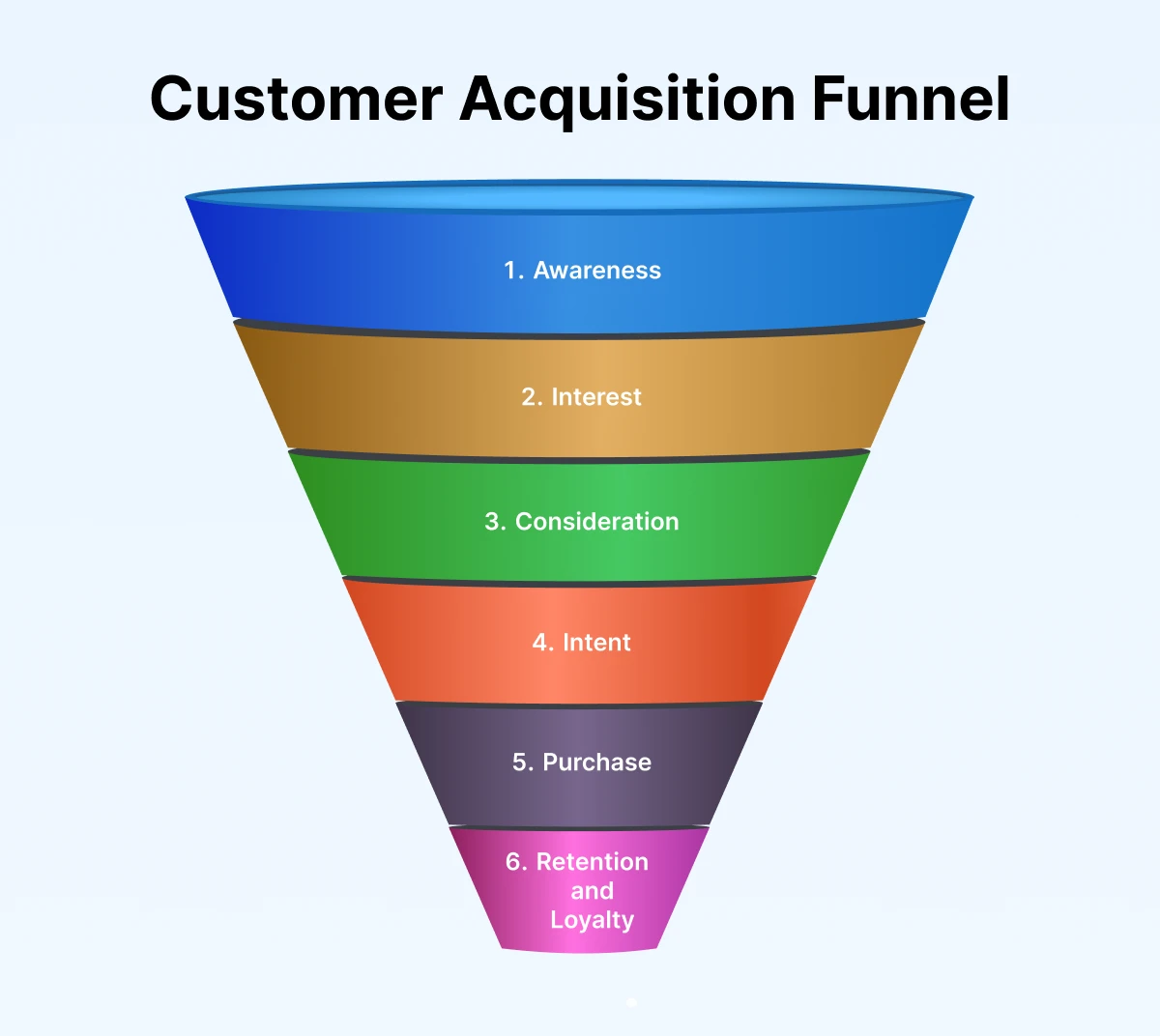
Each stage represents a key milestone in the customer’s decision-making process. Now let’s have a look at how:
- The first stage is Awareness – where you grab your target audience’s attention and make them aware of your product or service. In this case, you can use SEO, social media, and other marketing channels. It will help you to increase visibility and drive traffic to your website.
- Next is the Interest stage, where you pique the curiosity of your leads and encourage them to learn more. If you want to nurture this interest you need to create engaging content, informative blog posts, and targeted advertising to move them further down the funnel.
- The Consideration stage is where potential customers evaluate their options and decide if your offering fits their needs. When you offer detailed product information, customer reviews, and compelling calls to action. It will play a crucial role in helping sway their decision in your favor.
- The Intent stage signals that a lead is ready to take action. This is where you make it easy for them to convert, whether through an online purchase, a consultation request, or some other desired action.
- Once a customer completes a purchase, the funnel continues with the Retention and Loyalty stages. In this stage, you need to deliver exceptional customer service, offer loyalty programs, and maintain ongoing engagement to turn one-time buyers into lifelong advocates for your brand.
If you understand and optimize each step of the customer acquisition funnel. You can create an effective journey that drives more conversions and long-term business growth.
Customer Acquisition Channels
Do you know that the most effective customer acquisition strategy for your business will depend on your industry, target audience, budget, and resources? You should always experiment with different customer acquisition channels and continually analyze and optimize your efforts based on the results. Now let’s find what should be your customer acquisition strategy for each channel.
Digital Marketing Channels
Do you know businesses use online platforms to create direct connections with their audience? Social media, search engines, and email boost visibility and spark engagement in today’s digital world. Let’s find the most effective digital marketing channel for customer acquisition.

1. Search Engine Optimization (SEO)
It optimizes a website’s content and structure to improve its visibility in search engine results organically. It focuses on enhancing relevance and authority for specific keywords, attracting organic traffic, and establishing credibility with potential customers.
2. Content Marketing
It is a popular customer acquisition channel for businesses. It entails creating valuable, relevant content to engage a target audience, build trust, and establish authority. It includes various forms like blog posts, videos, and ebooks. This aims to address audience pain points and provide solutions to drive website traffic and conversions.
3. Social Media
This channel utilizes platforms like Facebook, Instagram, X, and more to promote products or services, engage with the audience, and build brand awareness. It includes content creation, ads, and community engagement to drive website traffic, generate leads, and build meaningful relationships with customers.
4. Email Marketing
It sends targeted emails to prospects and customers to nurture relationships, promote products, and drive conversions. Email marketing includes list building, segmentation, and performance tracking to communicate directly, deliver relevant content, and boost engagement and sales.
5. Pay-Per-Click (PPC) Advertising
This includes bidding on keywords to display ads on search engines or platforms. Advertisers pay only when users click. PPC makes it cost-effective for driving targeted traffic. You can generate leads, and increase conversions by placing ads in front of potential customers actively searching for related products.
Inbound Marketing Channels
These channels for marketing have an influence on potential buyers through organic means. It dishes out valuable content and experiences through SEO, content marketing, and social media buzz. This approach syncs up with what customers dig and need.

1. Creating Valuable Content
It relies on valuable content like blog posts, videos, and infographics to attract and engage audiences. Your businesses can establish credibility and build relationships with potential customers by offering resourceful content.
2. Lead Generation Tactics
This tactic captures the interest and contact information of potential customers. Lead generation strategy involves offering gated content, using lead capture forms, and providing incentives like discounts to encourage sign-ups. It is recommended to build a database of qualified leads for future marketing efforts.
3. Conversion Rate Optimization (CRO)
It focuses on optimizing website elements to increase the percentage of visitors who take desired actions. You can enhance conversion rates and drive more sales and revenue when you improve website usability, CTAs, and messaging.
Outbound Channels
These channels play a key role in taking the initiative to contact possible clients. Cold calling, direct mail, and laser-focused ads aim to kick off conversations and stir up quick interest. These methods have an impact on lead generation efforts.

1. Cold Emailing
This approach includes sending unsolicited emails to potential customers to initiate sales conversations and generate leads. It requires careful targeting and compliance with anti-spam regulations to be effective and avoid being marked as spam.
2. Direct Mail
It refers to sending physical mail pieces, like letters or postcards, to targeted prospects through postal mail. It’s a traditional tactic for driving brand awareness and delivering personalized offers or promotions directly to recipients’ mailboxes.
3. Telemarketing
This acquisition channel unsolicited phone calls to prospects to promote products, generate leads or conduct market research. It’s an interactive way to engage with potential customers but requires compliance with regulations and respect for customers’ preferences to maintain trust.
Partnerships and Collaborations

Do you know it is an effective strategy for customer acquisition programs? It includes teaming up with other businesses or organizations to reach new audiences and acquire customers.
This could include joint marketing campaigns, co-branded promotions, or mutually beneficial alliances. Undoubtedly, you can expand your reach and attract new customers more effectively. When you leverage the existing customer bases and networks of partner organizations.
Referral Programs

Referral programs incentivize existing customers to refer new customers to a business in exchange for rewards or benefits. This strategy relies on word-of-mouth marketing. Satisfied customers are encouraged to share their positive experiences with friends, family, and colleagues.
These customer referral programs are highly effective for acquiring new customers. As it is referred customers tend to have higher trust and loyalty and are more likely to convert.
Influencer Marketing

This is an amazing approach to acquiring new customers. It requires partnering with influential individuals or content creators who have a large and engaged following within a specific niche or industry. These influencers promote a business’s products or services to their audience through sponsored content, reviews, or endorsements. Undeniably, it can help businesses reach highly targeted audiences, build brand credibility, and drive customer acquisition. They leverage the trust and authority of the influencer with their followers.
What is a Customer Acquisition Strategy?
Customer acquisition strategy is a formula that you can use to achieve your e-commerce goals. It’s not a magic bullet, but it will give you the tools to understand how to get more customers for your e-commerce business. For new businesses or even those that have been around for a few years.
When you are looking to build a sustainable business. There is no doubt that finding ways to acquire new customers quickly and cheaply is the key to survival. To do that, you need an effective strategy for eCommerce.
A good acquisition strategy is constantly evolving. It’s based on data that can help you better understand your customers and potential customers, from their age and gender to how they like to spend their money.
Customer acquisition is a critical part of your strategy. Its intention is to drive customers to your website, and from there, you can use inbound marketing to close the sale.
Four key factors of Customer Acquisition Strategy (CAS) can give your business a competitive edge in the market.
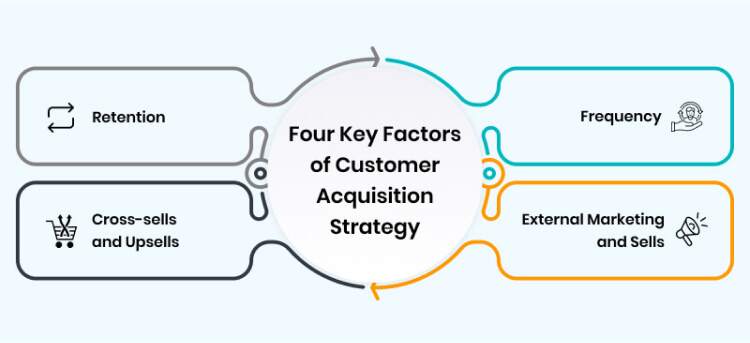
- Retention
- Cross-sells and Upsells
- Frequency
- External Marketing and Sales
1. Retention – Retaining existing customers is a critical part of any CAS. This can be done by ensuring that you are meeting your customers’ needs. Providing excellent service will not only ensure repeat purchases. But, it will also encourage recommendations and referrals.
2. Cross-sells and Upsells – Customers who have made more than one purchase from your store are more likely to spend more on their next visit than those who have only made a single purchase. You can encourage cross-selling by offering products that complement the initial purchase. Also, you can up-sell by offering higher-end or luxury versions of the product purchased.
3. Frequency – You should aim to make your store as accessible as possible for your customers and increase the frequency with which they visit it. This can be done by providing high-quality content that is interesting, relevant, and valuable to them. It directs communication with your customers to inform them about new products or services.
4. External marketing and sales – External marketing comprises all forms of marketing outside of your store – including public relations, social media, and targeted campaigns. You will gain visibility and recognition in your market and ensure maximum impact on customers’ perception of how your brand stands out from the rest.
8 Best Customer Acquisition Strategies
The CAS is the vehicle by which your business acquires new customers and grows. At any stage of your company, you should have a clear understanding of how you are bringing in new customers and growing your business.
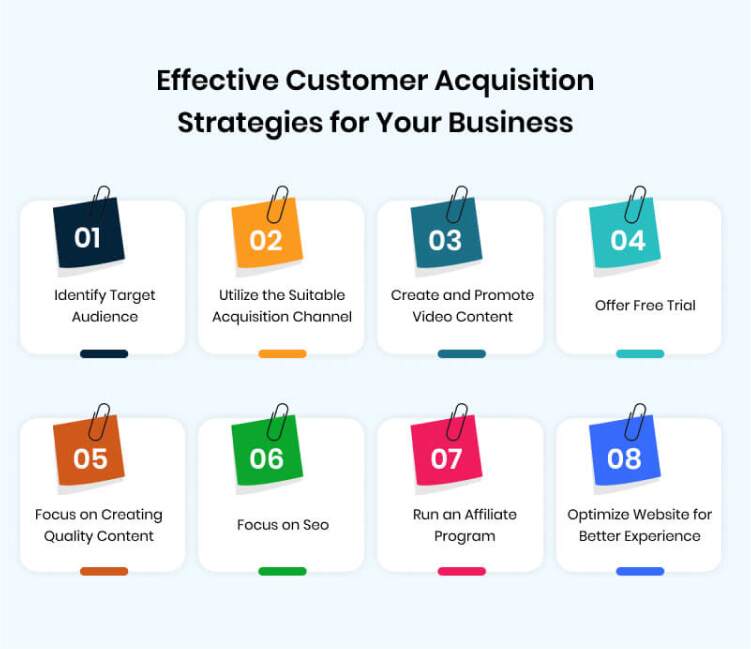
There are many key factors for developing a strategy for your business. Let’s take a look at the 9 best customer acquisition strategies (CAS).
- Identify Target Audience
- Suitable Acquisition Channel
- Create and Promote Video Content
- Offer Free Trial
- Quality Content
- Focus on SEO
- Run an Affiliate Program
- Optimize Website for Better Experience
1. Identify Target Audience
Figure out who are your customers. Make a list of their characteristics and get to know what they like and dislike about your brand. Find out what needs your customers have and how can you fulfill them. This information is crucial as it will help you create not only a great product but also a great company culture.
We have to make sure that we have the right target audience before we start figuring out what acquisition channels to utilize.
- Identifying who you are targeting in your marketing and sales efforts. It will be more effective and can lead to better gains in growth in your business.
- To figure out who you’re trying to sell to, first, decide what you’re selling and try to picture your ideal customer or client.
2. Suitable Acquisition Channel
There are multiple service channels out there that you can tap into. But, some are more suitable for your business than others. The correct key to a suitable acquisition channel is understanding. You need to perceive what your options are, how they relate to each other, and which ones will give you the absolute best outcomes.
- Online is a fantastic way to acquire customers at an economical price. If you are searching for an inexpensive, easy manner to acquire new customers. You will agree with me that the Internet is a fantastic place to start.
- Online can be a lot more than simply a place to promote your business products and services. It’s also an excellent option for promoting brand awareness, as well as building up a household name.
3. Create and Promote Video Content
When it comes to lead generation and customer acquisition, video content has been proven to deliver results. For example, a survey by Brightcove found that 74% of B2B marketers are using video as a content marketing tactic. As you can see from the example below. We’ve had great success with our own campaigns.
- Video content is one of the most popular things people share and watch today. According to a study by Cisco, by 2017, people will be consuming over 80% of their content through video.
- Creating and promoting video content is one of the most important ways to reach your target audience.
- Using video content is not only a solid B2C but also among very effective B2B marketing strategy a business can employ.
4. Offer Free Trial
Attracting new customers is not an easy job. It is always useful to have multiple options to acquire new customers and convert them into loyal customers.
- A free trial offer is a great way to compel your potential customers to experience your product.
- It helps them know more about your product and also acts as a way to generate leads for your brand. Even if they don’t become a customer after their trial period. They will remember your brand because they’ve experienced it before.
- It’s always good to let them use the product first before asking them to purchase it. After all, that is what a free trial is all about.
5. Quality Content
We all love to share content on social media. But how do we really know if it’s helping our business? Or that what we’re sharing is working or not?
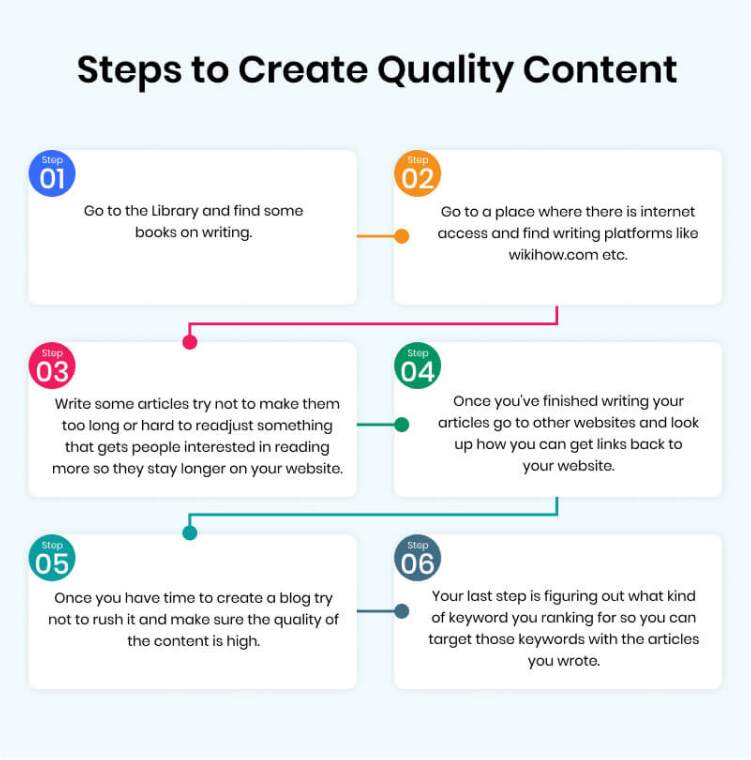
Creating an online presence for your business can be a very difficult task. In particular, if you don’t know what you’re doing. When it comes to creating quality content for your website. I want to show you how it’s done. This can be done by just following these simple steps:
- Go to the Library and find some books on writing.
- Go to a place where there is internet access and find writing platforms like wikihow.com etc.
- Write some articles try not to make them too long or hard to readjust something that gets people interested in reading more so they stay longer on your website.
- Once you’ve finished writing your articles go to other websites and look up how you can get links back to your website.
- Once you have time to create a blog try not to rush it and make sure the quality of the content is high.
- Your last step is figuring out what kind of keyword you ranking for so you can target those keywords with the articles you wrote.
6. Focus on SEO
SEO stands for search engine optimization. It includes creating a content strategy that helps your site show up at the top of search engine results like Google, Bing, and Yahoo.
Businesses need to focus on SEO to make sure they are creating a good CAS.
These days, people go online and search for products they would like to buy. There are hundreds of sites that offer the same products. But, consumers usually choose the ones that show first in their search results.
How SEO can help you?
- It helps you get more targeted visitors. So, you know that they are there looking for what you have to offer.
- It can help you in getting your website to the 1st page of the search engine results.
7. Run an Affiliate Program
The affiliate program is one of the traditional methods for online marketing. This type of marketing helps companies attract new business by placing banners, buttons, and links on their websites. This way businesses can gain new customers. While users can make money by promoting products and making sales.
- There is no product, service, or even a blog post for which no one would need marketing. On the flip side, if you’re new in the game of creating a profitable business and aren’t having much success in attracting quality customers. You definitely will need to find some other channels.
- Once you decide to move forward with setting up an affiliate program for your website, blog, or any other product or service. You will be immediately given the opportunity to increase your sales. While at the same time building a strong customer base.
8. Optimize the Website for a Better Experience
No matter what business you’re in, your website needs to be optimized. You may think that it’s working just fine. On the other hand, if you want to improve your business, then you need to put in the effort to improve your website. When people are looking around your site. They can tell if you’ve taken the time to optimize.
Here are some of the benefits of optimizing your site:
- It is way easier for people to find what they are looking for on your site.
- Optimized content is way easier for both the search engines and people to read through.
- You will have a better time using social media services like Facebook, Twitter, and Google+.
- Your bounce rate will go down, meaning more people will stick around and check out more than just one page on your site.
- No more confusion from duplicated content.
How to Enhance Your Customer Acquisition Strategy?
Any company that desires to succeed in today’s business world has an effective strategy. However, the actual tactics used tend to vary from industry to industry.
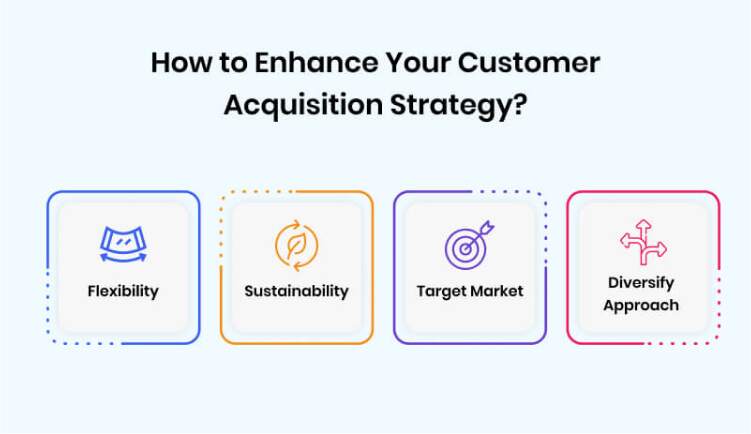
For example, product or service providers can utilize free trials and price promotions. While service businesses often rely on building personal relationships with potential clients.
Regardless, acquiring new customers involves a combination of creativity, ingenuity, strategy, and hard work. In this context, some things are just not as easy as they seem.
Let’s take a look at some of the effective ways to enhance customer acquisition strategy.
1. Flexibility
There is no doubt that customers are the lifeblood of your business. So, it’s critical to have a strategy to acquire them. While there are many strategies for customer acquisition (SEO, Display, Social, SEM) one of the most overlooked and effective is flexibility.
The flexibility to change your marketing message and trick or treat various channels. You should plan on using several channels. You don’t know which ones will give you the best return.
You want to reach as many prospects as possible without burning cash. If you are stuck on one channel and it’s not working you are wasting time, energy, and money.
The basic framework is this:
- Figure out what you want to do with your marketing
- Create a marketing message that gets people’s attention
- Create an ad that delivers your message
- Run an ad on a channel that delivers the best ROI
- Monitor and focus on the most successful channels
2. Sustainability
When businesses get started, the focus is often narrowed to revenue and marketing. While successfully acquiring new customers is important, it’s equally crucial to consider sustainability when doing so. Do you know that the expansion of most businesses relies on the acquisition of new customers through marketing?
3. Target Market
Social media has flooded the market with individuals and companies fighting to gain more market share. But why is it important to target a specific market of new customers?
The main focus of any company should be on how to reach its desired demographic as quickly as possible. I will use myself as an example. I am a student at university and I prefer to shop with small businesses in my local community.
This demographic is a huge target market that has not been targeted by many small companies or startups. When searching for your target market you must ask yourself who are you trying to reach? Literally, think about it.
4. Diversify approach
Once you’ve brainstormed a solid list of CAS examples. The next step is to decide which ones will work for your business. Generally, you’ll need to mix and match different types of customer acquisition strategies to break through the noise and stand out from the crowd.
How to Measure Customer Acquisition?
It tracks various metrics and analyzes data throughout the customer journey. Here are steps to measure customer acquisition effectively:
1. Define Key Metrics
Identify specific metrics aligned with your business goals. These may include:
- Number of New Customers: The total count of new customers acquired in a given period.
- Cost Per Acquisition (CPA): The average cost incurred to acquire a new customer.
- Conversion Rate: The percentage of prospects who become paying customers.
- Channel-Specific Metrics: Track metrics like click-through rates, conversion rates, or engagement metrics for each acquisition channel (e.g., social media, email, paid ads).
2. Set Up Tracking Systems
You need to use tools like Google Analytics, CRM software, or marketing automation platforms to track customer acquisition metrics. You must have to ensure that these systems are properly configured to collect relevant data.
3. Attribution Analysis
It is crucial to understand which marketing channels or touchpoints contribute most to customer acquisition. You can use attribution models to attribute conversions to specific interactions or channels along the customer journey.
4. Calculate Customer Acquisition Cost (CAC)
CAC stands for Customer Acquisition Cost, which refers to the total cost incurred by a company to acquire a new customer. It includes all expenses associated with marketing and sales efforts aimed at acquiring new customers, such as advertising costs, sales commissions, salaries of marketing and sales teams, and overhead costs.
CAC Formula: The formula to calculate Customer Acquisition Cost (CAC) is:
CAC = Total Marketing and Sales Expenses / Number of New Customers Acquired
CAC Example: Let’s say a company spent $10,000 on marketing and sales efforts in a month and acquired 100 new customers during the same period. The CAC would be calculated as follows:
CAC= $10,000100 / $100 = $100 per customer
5. Lifetime Value (LTV)
You can measure the value a customer brings over their entire relationship with your business. Compare LTV against CAC to understand the profitability of acquiring customers.
6. Monitor Cohort Analysis
You can track the behavior and performance of groups of customers acquired during the same period. It analyzes their engagement, retention rates, and purchasing patterns to understand the effectiveness of acquisition efforts.
7. Refinement and Testing
Continuously refine strategies based on data analysis. Test different acquisition channels, messaging, or campaigns to optimize performance.
8. Customer Feedback
Don’t overlook the importance of gathering feedback from new customers about their acquisition experience. You can use surveys or feedback forms to understand their journey, pain points, and satisfaction levels.
9. Regular Reporting
Create regular reports summarizing key customer acquisition metrics. This helps in evaluating performance, identifying trends, and making data-driven decisions to enhance acquisition strategies.
How to Leverage Technology for Customer Acquisition?

You can enhance every stage of the CA process, from lead generation and nurturing to conversion and retention. Ultimately, driving growth and success for your business. Let’s find out how you can do that.
1. Customer Relationship Management (CRM) Systems
CRM systems are technology platforms that enable businesses to manage interactions with current and potential customers. These systems store customer data, track interactions, and provide insights to help businesses better understand their customers’ needs and preferences.
You can streamline customer acquisition processes, personalize communications, and nurture leads more effectively with a CRM system. It drives conversions and builds long-term relationships.
2. Marketing Automation Tools
These customer acquisition marketing tools automate repetitive tasks and workflows, such as email campaigns, social media posting, and lead nurturing. They help businesses to send targeted messages to prospects at the right time. Based on their behavior and preferences. With marketing automation tools, you can scale your customer acquisition efforts, improve efficiency, and deliver personalized experiences.
3. Analytics and Tracking Platforms
Do you know analytics and tracking systems are crucial? These platforms track key metrics such as website visits, conversion rates, and customer engagement. These allow you to measure the effectiveness of customer acquisition efforts. When you analyze customer data and identify trends. It will be easier for you to create effective marketing strategies, allocate resources more efficiently, and make data-driven decisions to improve customer acquisition outcomes.
4. AI and Machine Learning in Customer Acquisition
These groundbreaking technologies are increasingly being used to enhance customer acquisition efforts. They enable businesses to analyze large volumes of data, predict customer behavior, and personalize interactions at scale.
AI-powered tools can segment audiences, recommend personalized content, and optimize real-time customer acquisition marketing to improve targeting and conversion rates. These technologies help businesses to drive more efficient and effective CAS and improve ROI and business growth.
10 Most Popular Customer Acquisition Tools

Tools are essential for customer acquisition in businesses. They make the processes easier to provide valuable insights into consumer behavior, optimize marketing efforts, and offer scalability. These tools efficiently acquire new customers. Also, contribute to understanding the target audience, refining strategies, and staying competitive for building long-term customer relationships.
1. HubSpot Sales Hub
It is a comprehensive CRM platform offering tools for sales automation, email tracking, pipeline management, and analytics. It helps businesses streamline their sales processes, track interactions with prospects, and manage customer relationships effectively.
2. Content Square
It is an analytics and optimization platform that provides insights into user behavior on websites and apps. It offers data visualization, heatmaps, and behavioral analysis to help businesses understand user interactions, optimize content, and improve conversion rates.
3. Google Analytics
Google Analytics is a widely used web analytics service that tracks website traffic, user behavior, and other crucial metrics. It offers insights into audience demographics, acquisition channels, and user engagement, aiding businesses in making data-driven decisions to enhance their online presence.
4. Drift
It is a conversational marketing platform that facilitates real-time messaging, chatbots, and personalized interactions with website visitors. It helps in engaging prospects, qualifying leads, and providing immediate assistance. Thereby, improving customer experience and conversion rates.
5. ReferralCandy
ReferralCandy is a referral marketing platform that incentivizes customers to refer friends or contacts to a business. It automates referral programs, tracks referrals, and rewards customers, leveraging word-of-mouth marketing to acquire new customers.
6. Unbounce
It is a landing page builder that enables marketers to create and optimize landing pages without coding skills. It offers A/B testing, customizable templates, and tools to improve conversion. It makes it easier to drive traffic and capture leads.
7. GetResponse
GetResponse is an all-in-one marketing platform that includes email marketing, automation, landing page creation, and webinar hosting. It helps businesses build and manage customer relationships through various marketing channels.
8. Outgrow
It is an interactive marketing platform that allows businesses to create quizzes, calculators, assessments, and other engaging content to generate leads. It helps in capturing audience attention and gathering valuable data for lead qualification.
9. Mailchimp
Mailchimp is a popular email marketing platform offering tools for designing, sending, and analyzing email campaigns. It helps businesses reach and engage their audience through personalized emails and automation.
10. Wunderkind
Wunderkind (formerly BounceX) is an AI-powered marketing platform focused on behavioral targeting and personalization. It assists in delivering tailored messages and experiences to website visitors, increasing engagement and conversions.
Challenges and Solutions in Customer Acquisition

When you address challenges with strategic solutions tailored to your business and target audience. You can enhance your customer acquisition efforts and drive sustainable growth over time. Now let’s find potential challenges and solutions.
1. Adapting to Changes in Consumer Behavior
You cannot deny the fact that consumer behavior is constantly evolving. They’re driven by technological advancements, cultural shifts, and economic changes. If you want to effectively acquire customers you should stay agile. You will need to adapt their strategies to meet changing consumer preferences and expectations.
This involves conducting regular market research, analyzing customer data, and leveraging technology to understand and anticipate shifts in consumer behavior.
2. Overcoming Competition
There is no doubt that businesses face intense competition from both established players and new entrants in the market. Do you want to stand out and acquire customers effectively? In this case, you need to differentiate yourself by offering unique value propositions, exceptional customer experiences, and innovative products or services.
This may involve conducting competitor analysis, identifying gaps in the market, and positioning the business as a leader in its niche.
3. Budget Constraints
It is needless to say limited budgets can pose significant challenges for businesses looking to acquire customers. Particularly, for small and medium-sized enterprises (SMEs) or startups with limited resources. You need to prioritize their marketing efforts based on cost-effectiveness and ROI potential to overcome budget constraints.
This may involve focusing on low-cost or free marketing channels such as social media, content marketing, and email marketing. Basically. it leverages partnerships and collaborations to extend reach, and optimize marketing spend through data-driven decision-making.
4. Strategies for Overcoming Common Obstacles

This may include investing in customer relationship management (CRM) systems to improve targeting and personalization.
You can leverage data analytics to optimize marketing campaigns, track performance, and invest in continuous learning and development. This will help you to stay ahead of industry trends and consumer preferences.
You can enhance your customer acquisition approach and drive sustainable growth by adopting a proactive and strategic approach to overcoming obstacles.
5 Customer Acquisition Examples From Top Brands
It is critical to business growth, and top brands employ diverse strategies to attract and retain customers. Let’s take a look at customer acquisition examples from renowned brands.
1. Apple
Apple’s customer acquisition strategy includes meticulously orchestrated product launches that generate immense anticipation and excitement among consumers. They achieve this through a combination of secretive product development, carefully curated marketing teasers, and high-profile launch events. These methods create buzz and drive both new customer interest and repeat purchases.
2. Amazon
Amazon uses a multifaceted approach to customer acquisition. They mostly utilize data-driven insights to personalize the shopping experience. They employ targeted advertising across various digital platforms to offer promotions and discounts to attract new customers. Additionally, Amazon’s Prime subscription service acts as a powerful acquisition tool. It provides perks like free shipping, exclusive deals, and streaming services to incentivize sign-ups.
3. Nike
Nike focuses on creating aspirational brand experiences through captivating marketing campaigns and strategic partnerships. They utilize celebrity endorsements and sponsorships of high-profile events. Also, they collaborate with popular athletes and artists to engage with their target audience. They also employ digital marketing channels effectively. Most importantly, they leverage social media platforms and interactive experiences to connect with consumers and drive sales.
4. Netflix
Netflix can be a great example for you. Basically, they revolve around data analytics and personalized content recommendations. They analyze user behavior and preferences to deliver tailored suggestions to attract new subscribers. Also. they offer free trial periods to entice potential customers and remove barriers to entry. Furthermore, Netflix invests heavily in original content production to create exclusive shows and movies to differentiate its service and attract subscribers.
5. Tesla
You all know Tesla for its electric vehicles. They adopt a disruptive approach to customer acquisition in the automotive industry. They prioritize direct-to-consumer sales through sleek showrooms. Where potential buyers can experience the brand firsthand and schedule test drives. Tesla also utilizes innovative marketing techniques, such as viral social media campaigns and referral programs.
Customer Acquisition Case Studies
EcoThreads is a startup in the e-commerce industry, specializing in handmade artisanal products. With a limited marketing budget and a desire to rapidly acquire customers, they turned to digital marketing strategies to drive growth and expand their customer base.
Now let’s explore what customer acquisition channels they used. The notable challenges they faced, and strategies they utilized to bring results.
Challenges
Now let’s find the notable challenges businesses face to acquire new customers. If you’re an entrepreneur these potential challenges you may need to face.
- Limited brand awareness: As a new entrant in the market, EcoThreads faced the challenge of building brand recognition and attracting customers to their online store.
- Competitive landscape: The e-commerce space is highly competitive, with established players dominating market share. They needed to find ways to differentiate themselves and stand out among competitors.
- Tight budget: With limited financial resources, EcoThreads needed to prioritize cost-effective customer acquisition marketing strategies to deliver measurable results within their budget constraints.
Strategies Implemented
What customer acquisition strategies EcoThread follow to get the desired result? Let’s find the strategies thy implemented.
- Search Engine Optimization (SEO): EcoThreads optimized their website for relevant keywords related to their products. It helped them to ensure better visibility in search engine results pages (SERPs). You can create high-quality content, build backlinks, and optimize on-page elements. Their SEO played a considerable role to improve your organic search rankings and attract more organic traffic to your website.
- Content Marketing: They invested in content marketing efforts to engage with their target audience and showcase the unique value of their products. They created a blog featuring articles, tutorials, and behind-the-scenes stories about their artisans and products. This content educated and inspired their audience and helped establish EcoThread as a trusted authority in the artisanal goods space.
- Social Media Marketing: They used social media platforms such as Instagram, Facebook, and Pinterest to showcase their products, engage with followers, and drive traffic to their website. They posted visually appealing images and videos of their products, ran targeted ad campaigns, and collaborated with influencers and micro-influencers to reach a wider audience and increase brand awareness.
- Email Marketing: Also, they implemented an email marketing strategy to nurture leads and encourage repeat purchases. They collected email addresses through their website and incentivized sign-ups with discounts or exclusive offers. They then sent personalized email campaigns featuring product recommendations, promotions, and updates to keep subscribers engaged and drive conversions.
Results
Now let’s time to measure the result. Let’s see the result of EcoThreads so that you can also experiment with it for your business.
- Increased website traffic: EcoThreads saw a significant increase in organic search traffic through their SEO efforts and content marketing initiatives, with their website ranking higher for relevant keywords.
- Improved brand awareness: Social media marketing and influencer collaborations helped them build brand recognition and reach a broader audience. It resulted in increased followers and engagement on their social media profiles.
- Higher conversion rates: Their email marketing campaigns improved conversion rates and higher customer retention. Subscribers were more likely to make purchases and return to the website for future purchases.
How Does a Smart Customer Acquisition Process Help Grow Faster?
The smart acquisition process plays a key role in the sustainable and long-term success of any e-commerce business. It starts with the right acquisition strategy, through to effective use of resources and tools. It enables clear KPIs (Key Performance Indicators). It allows you to monitor the results of your work.
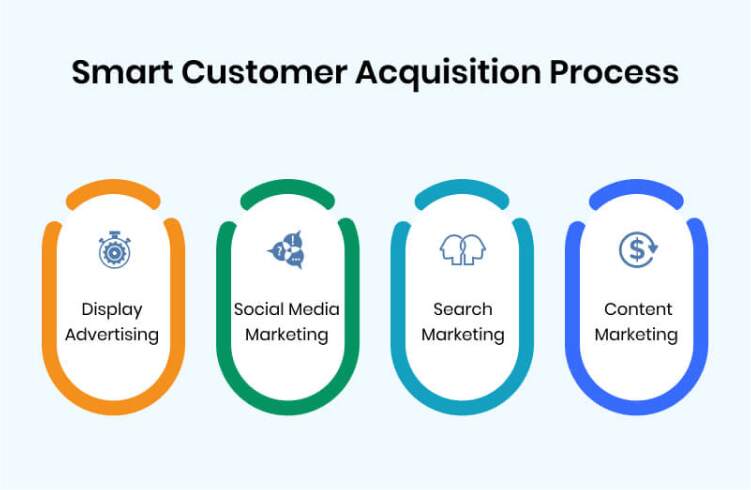
A smart customer acquisition process gives you confidence in choosing the right channels and investing according to your particular business model.
1. Display Advertising
Display advertising helps your brand grow by reaching the people most likely to purchase a product or service based on their online behavior. It’s no surprise that display has become the preferred brand-building investment across all industries.
You have to advertise your products and services on the Internet. It is one of the easiest ways to reach new customers.
2. Social Media Marketing
Social Media Marketing is the new sensation in marketing. Everyone owns a smartphone and people are using it to surf the internet and search for things that they want, need, or any information.
The Internet has changed the way businesses operate. It should be considered in your marketing plan. The internet has changed the way companies do business. It should be considered as a part of your marketing plan.
- Social media marketing is one of the best ways to connect directly with your customers and prospects. It’s an amazing tool that allows you to focus on creating content and engaging with your ideal customers.
- If you are really keen on using the power of social media for your business or for your organization. There are several things that you should be doing to ensure success.
3. Search Marketing
Search marketing is one of the best customer acquisition strategies for startups. It is crucial to build up a customer base. The more customers you have the easier it will be to grow with your startup.
- Customers from search engines are willing to invest more in your niche. If you do not make an active step in reaching out to these people, they might never reach your products or services.
- Potential customers are not only the people who type directly into the search bar. However, also those who use “related searches” and see what kind of products and services are good
4. Content Marketing
This effective method uses online outlets such as blogs and social media platforms to give potential customers insight into your business and your products. This can be supplemented by offering subscriber-only discounts, competitions, and other incentives. But, you’ll have to make sure that you keep those visitors coming back for more.
- As the digital era is growing, more companies and so many small businesses are increasing their content marketing activities to reach their potential customer faster.
- Content marketing is your next customer acquisition process. It’s an innovative and effective method of making sure that you reach the right people with the right messages to persuade them. Your brand is one that they need to know about.
How an AI Chatbot Can Help Acquire More Customers?
Chatbots are the new technological frontier in customer service and they are already starting to be used by companies to meet more consumer demand.
Similar to how companies have used multiple channels (email, social media, and telephone) to communicate with their customers, chatbots give companies another way to interact with their consumers.
What makes REVE Chat’s AI Chatbot so exciting is that it helps companies talk directly with their customers. This chatbot can quickly help acquire new customers, resolve issues, and upsell higher-margin items. With these added features, REVE Chat can create more lifetime value for e-commerce stores and brands. Sign Up now and enjoy a 14-day free trial.
Frequently Asked Questions
Businesses use strategies to grab and keep new customers. They spot target markets, reach out to possible buyers, and turn them into fans. They do this through various marketing and sales tricks.
Customer acquisition has four key steps. First, find your ideal customers. Next, attracting leads. Then, turn those leads into buyers. Last, build strong relationships with customers. Each step moves potential buyers down the sales funnel. It starts with them knowing about you and ends with them buying and staying loyal.
Awareness, interest, consideration, and conversion form the backbone of acquisition. These elements shape how customers interact with brands. First, folks learn about a brand. Then, it catches their eye. Next, they mull over the product. Finally, they bite the bullet and make a purchase.
Businesses use customer acquisition forms to collect info from potential buyers. These forms, often found online, scoop up crucial details. Think contact info, likes, and what folks are into. This data helps businesses generate leads and automate their acquisition efforts.




